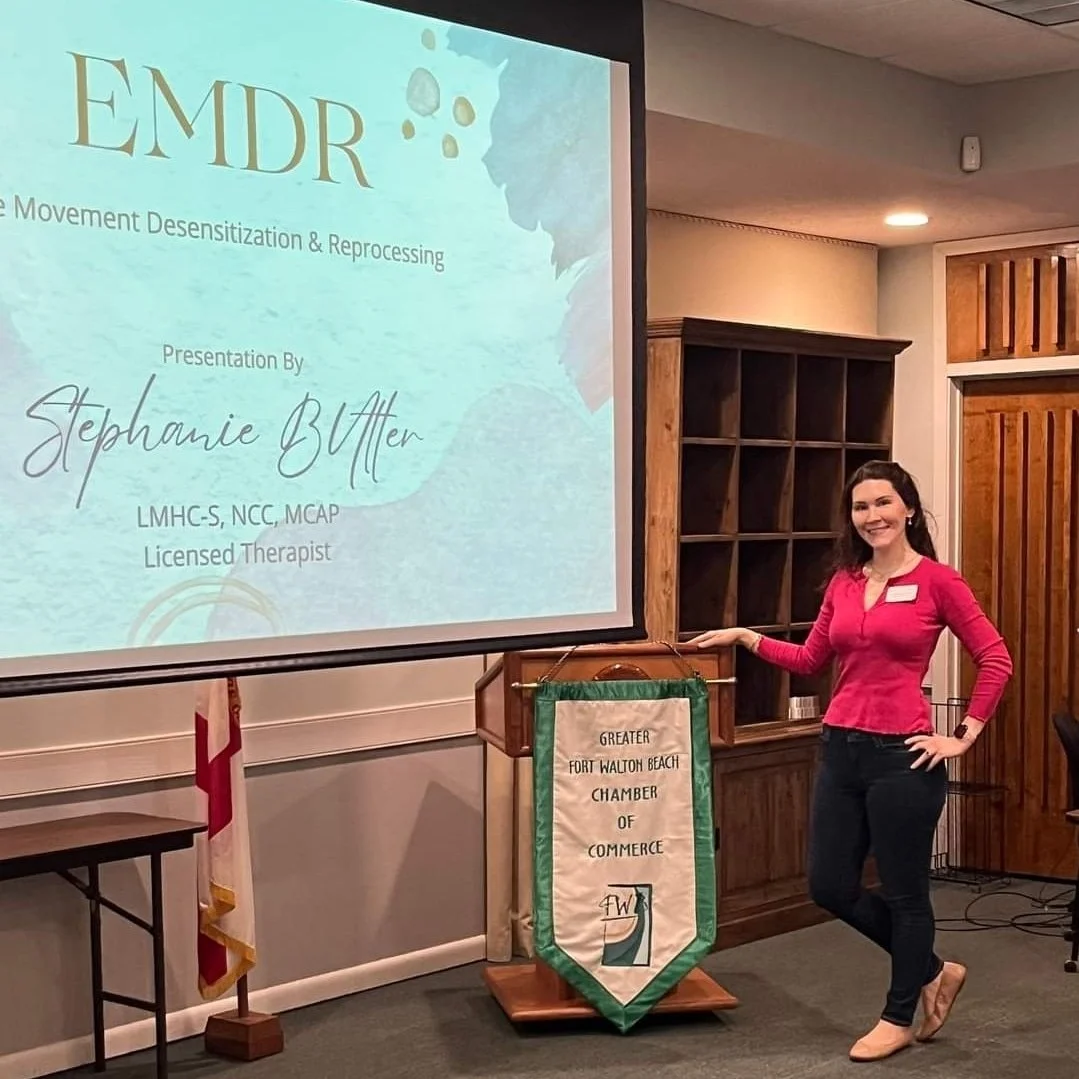EMDR vs ART: What’s the Deal?
If you’ve been researching trauma therapy, you’ve probably come across EMDR (Eye Movement Desensitization and Reprocessing). It’s been around for a long time, and there’s a good reason for that, it works. I’ve used EMDR with clients, I’m trained in it, and I’ve seen it create meaningful change.
But if you’ve also seen me talk about Accelerated Resolution Therapy (ART), you might be wondering:
"What’s the difference between EMDR and ART? And which one is right for me?"
That’s exactly what we’re going to explore in this blog.
Let’s Start with EMDR
EMDR has been a gold standard in trauma therapy since the 1980s. It was developed by Francine Shapiro, and it involves using bilateral stimulation (usually eye movements) to help people reprocess traumatic memories. The goal is to reduce the emotional charge connected to those memories so they no longer feel overwhelming or stuck.
Giving an EMDR presentation to the local Chamber of Commerce in Fort Walton Beach, FL.
EMDR typically involves recalling the trauma, naming thoughts, beliefs, and emotions associated with it, and then reprocessing those memories over multiple sessions. It can be incredibly effective for PTSD, anxiety, and other trauma-related concerns. There’s a large body of research backing it, and it’s widely used by therapists around the world.
I still use elements of EMDR in my work. I value the model, I’m trained in it, and I believe it helps many people.
So What Is ART, and How Is It Different?
Accelerated Resolution Therapy (ART) came onto the scene in 2008, developed by Laney Rosenzweig. While it also uses eye movements, ART is designed to work faster and with less emotional distress than traditional EMDR. In fact, many people find they can experience meaningful results in just a few sessions.
Here are a few key differences:
1. ART Is More Directive
In EMDR, the client often leads the process by recalling their memories and allowing their brain to guide the healing. ART, on the other hand, is more structured and therapist-guided. I help clients visualize their experience and then "replace" distressing images with more peaceful ones, using a technique called Voluntary Image Replacement.
2. ART Doesn’t Require Several Days of Post-Processing
One of the biggest reasons I love ART is that clients feel better right away and leave my office feeling better. With EMDR, because it’s less directive and more “free association,” it can take the brain 2 to 3 days to fully reconsolidate. I have heard from clients that they feel down or “out of it” for that time. As a past EMDR client, I have personally felt an “emotional hangover” for at least a day after EMDR. There is no recovery time with ART.
3. ART Is Often Faster
While EMDR typically takes place over several sessions, especially for more complex trauma, ART is designed to get to the root of the issue quickly. Some clients see noticeable improvement in just one to three sessions, even for long-standing issues.
4. ART Uses Imagery in a Unique Way
Both EMDR and ART involve reprocessing memories, but ART uses very specific imagery techniques to help you "edit" how those memories are stored. You’re not erasing what happened; you’re changing how your brain holds onto it. Many people say they still remember the event, but it no longer feels painful, scary, or overwhelming.
Why I Prefer ART (Most of the Time)
I’ve done both EMDR and ART personally, and I’ve used both with clients. I respect EMDR and continue to use it when it feels right. But overall, ART just feels more natural to me. It fits the way I work and the kind of results I want my clients to have: fast, deep, and lasting.
I’ve had many clients come to me after trying EMDR who ended up preferring ART. They often describe it as more calming, less emotionally intense, and easier to stay regulated throughout the session.
Which One Is Right for You?
That depends on what you need. Some people respond beautifully to EMDR. Others prefer the pace and structure of ART. You don’t have to decide right now. What matters most is that you find a path that helps you feel safe, supported, and truly seen.
If you’re curious about ART or want to know more about how it compares to your past therapy experiences, I’m happy to talk it through with you.
And if you’ve tried other therapies but still feel stuck, ART might be the shift you’ve been looking for.
Schedule a free consult with me today.
About The Author
With 20 years of experience in the mental health field with expertise in complex trauma, anxiety, & perfectionism, Stephanie A. Butler, LMHC-S, NCC, MCAP, helps clients heal what’s underneath perfectionism, anxiety, and emotional burnout. She owns Clarity Counseling & Wellness, a private therapy practice located in Shalimar, FL, and provides in-person sessions and virtual sessions throughout Florida. Stephanie specializes in trauma recovery using Accelerated Resolution Therapy (ART). Reach out via email at Stephanie@clarityonthecoast.com or the contact form to set up a free 15-minute consultation.
Still Wondering Which Trauma Therapy Is Right for You?
Choosing between EMDR and ART doesn’t have to feel overwhelming. Both are powerful tools, but if you’re looking for a faster, gentler, and more guided approach, Accelerated Resolution Therapy might be the fit you didn’t know you needed.
At Clarity Counseling & Wellness, I offer both EMDR-informed care and ART in Shalimar, near Fort Walton Beach, Florida. Many clients come to me after trying traditional therapy methods and say that ART helped them feel calm, grounded, and relieved, often in just a few sessions.
If you’re ready for something that works without the emotional hangover, I’d love to help you explore whether ART is a good match for your healing journey.
👉 Schedule your free 15-minute consultation and let’s talk through your options—no pressure, just clarity.



